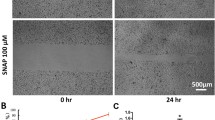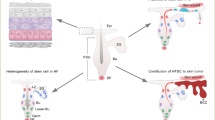Abstract
ClC-3, a member of the ClC chloride (Cl−) channel family, has recently been proposed as the primary Cl− channel involved in cell volume regulation. Changes in cell volume influence excitability, contraction, migration, pathogen-host interactions, cell proliferation, and cell death processes. In this study, expression and function of ClC-3 channels were investigated during epidermal stem cell (ESC) migration. We observed differential expression of CLC-3 regulates migration of ESCs. Further, whole-cell patch-clamp recordings and image analysis demonstrated ClC-3 expression affected volume-activated Cl− current (I Cl,Vol) within ESCs. Live cell imaging systems, designed to observe cellular responses to overexpression and suppression of ClC-3 in real time, indicated ClC-3 may regulate ESC migratory dynamics. We employed IMARIS software to analyze the velocity and distance of ESC migration in vitro to demonstrate the function of ClC-3 channel in ESCs. As our data suggest volume-activated Cl− channels play a vital role in migration of ESCs, which contribute to skin repair by migrating from neighboring unwounded epidermis infundibulum, hair follicle or sebaceous glands, ClC-3 may represent a new and valuable target for stem cell therapies.





Similar content being viewed by others
References
Arnaiz I, Johnson MH, Cook DI, Day ML (2013) Changing expression of chloride channels during preimplantation mouse development. Reproduction 145:73–84
Barrientos S, Stojadinovic O, Golinko MS, Brem H, Tomic-Canic M (2008) Growth factors and cytokines in wound healing. Wound Repair Regen 16:585–601
Blanpain C, Lowry WE, Geoghegan A, Polak L, Fuchs E (2004) Self-renewal, multipotency, and the existence of two cell populations within an epithelial stem cell niche. Cell 118:635–648
Brem H, Tomic-Canic M (2007) Cellular and molecular basis of wound healing in diabetes. J Clin Invest 117:1219–1222
Chen L, Wang L, Jacob TJ (1999) Association of intrinsic pICln with volume-activated Cl- current and volume regulation in a native epithelial cell. Am J Physiol 276:C182–C192
Diegelmann RF, Evans MC (2004) Wound healing: an overview of acute, fibrotic and delayed healing. Front Biosci 9:283–289
Duan D, Zhong J, Hermoso M, Satterwhite CM, Rossow CF, Hatton WJ, Yamboliev I, Horowitz B, Hume JR (2001) Functional inhibition of native volume-sensitive outwardly rectifying anion channels in muscle cells and Xenopus oocytes by anti-ClC-3 antibody. J Physiol 531:437–444
Ehrengruber MU, Deranleau DA, Coates TD (1996) Shape oscillations of human neutrophil leukocytes: characterization and relationship to cell motility. J Exp Biol 199:741–747
Ernest NJ, Weaver AK, Van Duyn LB, Sontheimer HW (2005) Relative contribution of chloride channels and transporters to regulatory volume decrease in human glioma cells. Am J Physiol Cell Physiol 288:C1451–C1460
Falanga V (2005) Wound healing and its impairment in the diabetic foot. Lancet 366:1736–1743
Fu X, Li H (2009) Mesenchymal stem cells and skin wound repair and regeneration: possibilities and questions. Cell Tissue Res 335:317–321
Fu X, Sun X, Li X, Sheng Z (2001) Dedifferentiation of epidermal cells to stem cells in vivo. Lancet 358:1067–1068
Guan YY, Wang GL, Zhou JG (2006) The ClC-3 Cl- channel in cell volume regulation, proliferation and apoptosis in vascular smooth muscle cells. Trends Pharmacol Sci 27:290–296
Gurtner GC, Werner S, Barrandon Y, Longaker MT (2008) Wound repair and regeneration. Nature 453:314–321
Hara-Chikuma M, Yang BX, Sonawane ND, Sasaki S, Uchida S, Verkman AS (2005) ClC-3 chloride channels facilitate endosomal acidification and chloride accumulation. J Biol Chem 280:1241–1247
Hart J (2002) Inflammation. 1: its role in the healing of acute wounds. J Wound Care 11:205–209
Heng BC, Cao T, Liu H, Phan TT (2005) Directing stem cells into the keratinocyte lineage in vitro. Exp Dermatol 14:1–16
Huang JB, Kindzelskii AL, Clark AJ, Petty HR (2004) Identification of channels promoting calcium spikes and waves in HT1080 tumor cells: their apparent roles in cell motility and invasion. Cancer Res 64:2482–2489
Huber SM, Butz L, Stegen B, Klumpp L, Klumpp D, Eckert F (2015) Role of ion channels in ionizing radiation-induced cell death. Biochim Biophys Acta 1848:2657–2664
Isbilen B, Fraser SP, Djamgoz MB (2006) Docosahexaenoic acid (omega-3) blocks voltage-gated sodium channel activity and migration of MDA-MB-231 human breast cancer cells. Int J Biochem Cell Biol 38:2173–2182
Kunzelmann K (2005) Ion channels and cancer. J Membr Biol 205:159–173
Lang F, Busch GL, Ritter M, Volkl H, Waldegger S, Gulbins E, Haussinger D (1998) Functional significance of cell volume regulatory mechanisms. Physiol Rev 78:247–306
Lavker RM, Sun TT (1982) Heterogeneity in epidermal basal keratinocytes: morphological and functional correlations. Science 215:1239–1241
Lavker RM, Sun TT (2000) Epidermal stem cells: properties, markers, and location. Proc Natl Acad Sci USA 97:13473–13475
Lemonnier L, Shuba Y, Crepin A, Roudbaraki M, Slomianny C, Mauroy B, Nilius B, Prevarskaya N, Skryma R (2004) Bcl-2-dependent modulation of swelling-activated Cl- current and ClC-3 expression in human prostate cancer epithelial cells. Cancer Res 64:4841–4848
Levy V, Lindon C, Zheng Y, Harfe BD, Morgan BA (2007) Epidermal stem cells arise from the hair follicle after wounding. FASEB J 21:1358–1366
Mao J, Chen L, Xu B, Wang L, Li H, Guo J, Li W, Nie S, Jacob TJ, Wang L (2008) Suppression of ClC-3 channel expression reduces migration of nasopharyngeal carcinoma cells. Biochem Pharmacol 75:1706–1716
Nilius B, Droogmans G (2003) Amazing chloride channels: an overview. Acta Physiol Scand 177:119–147
O’Shea KS (2004) Self-renewal vs. differentiation of mouse embryonic stem cells. Biol Reprod 71:1755–1765
Peng LH, Mao ZY, Qi XT, Chen X, Li N, Tabata Y, Gao JQ (2013) Transplantation of bone-marrow-derived mesenchymal and epidermal stem cells contribute to wound healing with different regenerative features. Cell Tissue Res 352:573–583
Qiu Z, Dubin AE, Mathur J, Tu B, Reddy K, Miraglia LJ, Reinhardt J, Orth AP, Patapoutian A (2014) SWELL1, a plasma membrane protein, is an essential component of volume-regulated anion channel. Cell 157:447–458
Ransom CB, O’Neal JT, Sontheimer H (2001) Volume-activated chloride currents contribute to the resting conductance and invasive migration of human glioma cells. J Neurosci 21:7674–7683
Reiisi S, Esmaeili F, Shirazi A (2010) Isolation, culture and identification of epidermal stem cells from newborn mouse skin. In Vitro Cell Dev Biol Anim 46:54–59
Rennekampff HO, Hansbrough JF, Kiessig V, Dore C, Sticherling M, Schroder JM (2000) Bioactive interleukin-8 is expressed in wounds and enhances wound healing. J Surg Res 93:41–54
Rohrbough J, Lamb FS, Nguyen H-N (2015) Regulation of ClC-3 Cl−/H+ transport and “gating” transients by chloride pathway residues and external protons. Biophys J 108:440a–441a
Salazar G, Love R, Styers ML, Werner E, Peden A, Rodriguez S, Gearing M, Wainer BH, Faundez V (2004) AP-3-dependent mechanisms control the targeting of a chloride channel (ClC-3) in neuronal and non-neuronal cells. J Biol Chem 279:25430–25439
Sardini A, Amey JS, Weylandt KH, Nobles M, Valverde MA, Higgins CF (2003) Cell volume regulation and swelling-activated chloride channels. Biochim Biophys Acta 1618:153–162
Schneider SW, Pagel P, Rotsch C, Danker T, Oberleithner H, Radmacher M, Schwab A (2000) Volume dynamics in migrating epithelial cells measured with atomic force microscopy. Pflugers Arch 439:297–303
Sontheimer H (2008) An unexpected role for ion channels in brain tumor metastasis. Exp Biol Med (Maywood) 233:779–791
Stock C, Schwab A (2015) Ion channels and transporters in metastasis. Biochim Biophys Acta 1848:2638–2646
Sylvia CJ (2003) The role of neutrophil apoptosis in influencing tissue repair. J Wound Care 12:13–16
Tiede S, Kloepper JE, Bodo E, Tiwari S, Kruse C, Paus R (2007) Hair follicle stem cells: walking the maze. Eur J Cell Biol 86:355–376
Ulloa-Montoya F, Verfaillie CM, Hu WS (2005) Culture systems for pluripotent stem cells. J Biosci Bioeng 100:12–27
Voss FK, Ullrich F, Munch J, Lazarow K, Lutter D, Mah N, Andrade-Navarro MA, von Kries JP, Stauber T, Jentsch TJ (2014) Identification of LRRC8 heteromers as an essential component of the volume-regulated anion channel VRAC. Science 344:634–638
Voura EB, Sandig M, Kalnins VI, Siu C (1998) Cell shape changes and cytoskeleton reorganization during transendothelial migration of human melanoma cells. Cell Tissue Res 293:375–387
Wang L, Chen L, Jacob TJ (2000) The role of ClC-3 in volume-activated chloride currents and volume regulation in bovine epithelial cells demonstrated by antisense inhibition. J Physiol 524(Pt 1):63–75
Wang GX, Hatton WJ, Wang GL, Zhong J, Yamboliev I, Duan D, Hume JR (2003) Functional effects of novel anti-ClC-3 antibodies on native volume-sensitive osmolyte and anion channels in cardiac and smooth muscle cells. Am J Physiol Heart Circ Physiol 285:H1453–H1463
Wang LW, Chen LX, Jacob T (2004) ClC-3 expression in the cell cycle of nasopharyngeal carcinoma cells. Sheng Li Xue Bao 56:230–236
Weylandt KH, Nebrig M, Jansen-Rosseck N, Amey JS, Carmena D, Wiedenmann B, Higgins CF, Sardini A (2007) ClC-3 expression enhances etoposide resistance by increasing acidification of the late endocytic compartment. Mol Cancer Ther 6:979–986
Zhang JJ, Jacob TJ (1997) Three different Cl- channels in the bovine ciliary epithelium activated by hypotonic stress. J Physiol 499(Pt 2):379–389
Zifarelli G, Pusch M (2007) CLC chloride channels and transporters: a biophysical and physiological perspective. Rev Physiol Biochem Pharmacol 158:23–76
Acknowledgments
We thank our colleagues for critical advices in the preparation of this manuscript. The research was supported by Grants from the National Natural Science Foundation of China (No. 81272121).
Author Contributions
Shirong Li, Chuan Cao, and Hongli Li conceived and designed the experiments; Rui Guo, Fuqiang Pan, Yanping Tian, and Hongli Li performed the experiments; Rui Guo and Chuan Cao analyzed the data; Rui Guo and Chuan Cao wrote the manuscript.
Author information
Authors and Affiliations
Corresponding authors
Ethics declarations
Conflicts of Interest
The authors declare no conflict of interest.
Rights and permissions
About this article
Cite this article
Guo, R., Pan, F., Tian, Y. et al. Down-Regulation of ClC-3 Expression Reduces Epidermal Stem Cell Migration by Inhibiting Volume-Activated Chloride Currents. J Membrane Biol 249, 281–292 (2016). https://doi.org/10.1007/s00232-015-9867-9
Received:
Accepted:
Published:
Issue Date:
DOI: https://doi.org/10.1007/s00232-015-9867-9




